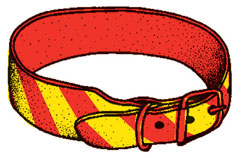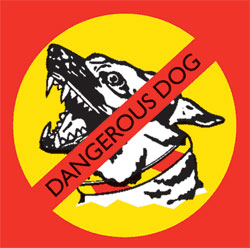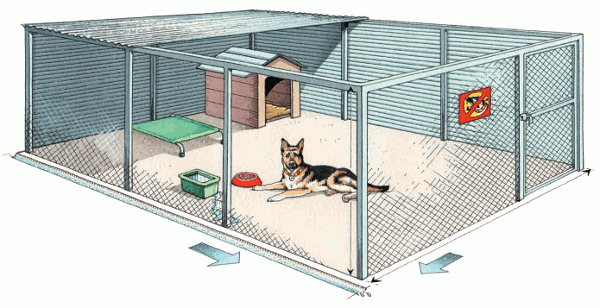Guard dogs
A dog that is kept for the purpose of guarding non-residential premises is automatically a dangerous dog under the Domestic Animals Act 1994.
This has effect throughout Victoria, and it cannot be revoked. The dog is a dangerous dog for life, even if it stops being used to guard non-residential premises. Retired guard dogs are still subject to the same housing and identification requirements as working guard dogs.
There are many requirements relating to a dog that has been declared dangerous because it is used to guard non-residential premises. These are prescribed in the Domestic Animals Regulations 2015.
As a dangerous dog, the following conditions are mandatory. There are penalties for non-compliance.
Penalties for failing to comply with guard dog laws
The government introduced additional laws that affect the owners of guard dogs.
Owners of:
- dangerous dogs declared due to attack
- attack-trained dogs
- guard dogs
- declared menacing dogs
- restricted breed dogs (both registered and unregistered)
can be jailed for up to 10 years, or for up to 5 years if their dog endangers someone's life, under the Crimes Act 1958.
Penalties for failing to comply with the keeping requirements for a dangerous dog in relation to:
- notification of where the dog is housed
- enclosure requirements
- requirements for wearing a collar and being kept on a lead and muzzled when off their property
- notifying perspective buyer in writing that the dog is a dangerous dog
can be imposed on owners.
Where the owner of a dog is under the age of 18 years, the parent or guardian of that owner will be deemed the legal owner of the dog and subject to any penalties or prosecutions.
Microchip identification
The owner of the dog must ensure that the animal is implanted with an ISO microchip in line with the Regulations (unless already microchipped prior to 20 May 2003).
This microchip identification number, along with other information as specified in the Regulations, must be supplied to the council with which the dog is registered — within 7 days of the dog being microchipped.
Collar

While a microchip is a permanent form of identification it is not visible. Dangerous dogs must also wear a prescribed collar at all times. The collar is specially designed to be visible from a distance and is reflective at night.
This means that at all times, whether on the owner's property or not, a dangerous dog can be recognised from a distance. This warns a person of the potential danger of the dog.
Collars for dangerous dogs must:
- consist of red stripes alternately spaced with yellow stripes, each being of a width of not less than 20 mm and not more than 30 mm and set diagonal to the rim of the collar
- have at least one colour that reflects light in the dark
- be made of durable materials
- be able to be securely fastened
- have a minimum width of: 25mm for a dog weighing not more than 40kgs or 50mm for a dog weighing more than 40kg.

It is important for safety purposes to warn people that a dangerous dog is kept on the premises. The owner of a dangerous dog must display prescribed warning signs at all entrances to the premises where the dog is kept warning people that a dangerous dog is kept on the premises. These signs also help to deter unwanted intruders from entering the guarded premises.
This warning sign must:
- be square with sides of at least 40cm
- be made of durable metal
- have at least one colour that is reflective
- comply with the Domestic Animals Regulations 2015.
For details of suppliers of restricted breed dog signs, contact your local council, or phone the Customer Service Centre on 136 186
Housing

When a dangerous dog is not guarding non-residential premises, the dog must be housed in an enclosure in such a way that it cannot escape, and that prevents it from injuring visitors to the premises. An enclosure must also:
- be constructed in such a manner that a person cannot have access to it without the help of an occupier of the premises who is of or over 18 years of age
- be fully enclosed
- have a weatherproof sleeping area
- have a minimum floor area of 10 square metres per dangerous dog
- have a minimum height of 1.8 metres
- have a minimum width of 1.8 metres
- contain walls, a floor, a drain, a roof and a gate that comply with the following details.
The walls of the enclosure must be fixed to the floor or constructed to be no more than 50mm from the floor.
The walls, roof and gate of the enclosure must be constructed of:
- brick, timber, iron or similar solid materials, or
- chain mesh manufactured from a minimum 3.15mm wire to form a uniform 50mm mesh or weldmesh manufactured from 4mm wire with a maximum mesh spacing of 50mm.
A combination of the above may be acceptable. The mesh size and construction detail is specified so that the enclosure will be escape-proof and so that people, particularly small children, cannot fit body parts such as hands into the enclosure with the dog.
The floor of the enclosure must be constructed of concrete and be graded to a drain for the removal of effluent.
The gate on the enclosure must contain a lock. It is a requirement that the enclosure is securely locked when the dog is in the pen.
Perimeter fencing

When a dangerous dog is guarding non-residential premises it is permitted outside the enclosure. However, the perimeter fencing surrounding the premises as described must have a minimum height of 1.8 metres and be constructed of:
- brick
- concrete
- timber
- iron or similar solid materials
- and the type of chain mesh.
The fence must be constructed and maintained in a manner that prevents the dog from being able to dig or otherwise escape under, over or through the fencing. All gates must be securely locked while the dog is guarding the premises.
If they believe the dog has escaped over the perimeter fencing, an authorised officer may also require that this perimeter have an inward facing overhang of 0.7 metres angled at 35 degrees to the horizontal plane.
Restraint
A dangerous dog must be muzzled and on a lead while the dog is outside the owner's premises or when not guarding outside the enclosure.
Notification
The owner of a dangerous dog must notify the Council within 24 hours if:
- the dog is missing
- the ownership of the dog changes
- the owner's address changes or the place where the dog is kept changes
- there is a change in the municipality where a dangerous, menacing or restricted breed dog is kept, owners must inform both the Council of the municipal district in which the dog was previously kept and the Council of the municipal district in which the dog is being kept within 24 hours of the change.
This keeps the Council informed of the location of dangerous dogs at all times. The Council will inspect the premises to ensure the Regulations are being adhered to.
Owners who sell, give away or transfer the ownership of a dangerous dog, including a guard dog, must notify the new owner in writing that the dog is deemed dangerous.
You may wish to use a pre-prepared template, which you can request from your local Council or email pet.welfare@agriculture.vic.gov.au
The Domestic Animals Regulations 2015 provide for and ensure a state-wide standard relating to the management of dangerous dogs. The uniform identification of dangerous dogs, and the identification of premises where they live is important for easy identification of these dogs. It is also vital for effective state-wide education programs, directed particularly at children.
The Domestic Animals Act 1994 is state legislation that is implemented by Municipal Councils.
This page is also available for download as a PDF document: Things you should know about guard dogs on non-residential properties ![]() [PDF File - 628.9 KB]
[PDF File - 628.9 KB]